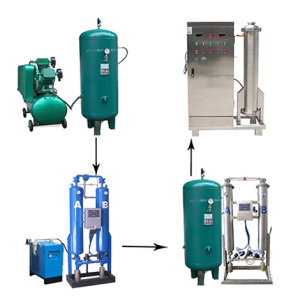Due to the high-efficiency broad-spectrum sterilization effect of the released active oxygen and its own physical and chemical properties, it has been widely used in the disinfection and epidemic prevention of livestock and poultry, aquaculture farms and drinking water. Using special materials, after high-voltage and high-frequency discharge, the ionized air generates ozone or active oxygen. Through the pipeline, evenly distributed to the livestock and poultry houses and drinking water:
(1) Kill bacteria and viruses in the air in the pen, degrade the ammonia, hydrogen sulfide and other harmful gases in the pen, make the air in the pen fresh, and reduce the chance of respiratory diseases.
(2) Kill bacteria, viruses, algae and other harmful microorganisms in drinking water and reduce the incidence of digestive tract diseases.
Basic functions of ozone generator:
(1) Thoroughly sterilize the air in the pen.
(2) Differentiate harmful gases such as ammonia and hydrogen sulfide.
(3) Sterilize and purify livestock and poultry drinking water.
Air disinfection system: used for disinfection of livestock and poultry environment-that is, air disinfection. The ozone produced by the machine is continuously distributed to the livestock and poultry house through the pipe by the air circulation timer, and is distributed with the livestock and poultry excrement in the house. The odor, ammonia, hydrogen sulfide and other harmful gases are removed by the differentiation reaction. When the odor, ammonia, hydrogen sulfide and other harmful gases are removed to a certain extent, the odor of active oxygen can be slightly smelled (4-5 meters away from the purifier. When the smell of ozone is enough, not too strong), bacteria and viruses such as Escherichia coli, staphylococcus, Newcastle disease, cholera, influenza and so on in the space of the house are basically killed.
Live oxygen is harmful to human and animal pathogenic bacteria and viruses at a lower than safe concentration (0.1PPM), that is, at a height of 3 meters, 4-6 mg per hour per square meter., (for example, a circle with a height of 3 meters and a 500 square meter The ozone output is 20g/h, working for 10 minutes per hour), it has a strong bactericidal effect, and the killing rate is above 99%. Under normal circumstances, the temperature is low and the humidity has a good killing effect (relative humidity is greater than 70%). This is due to the increase in relative humidity, which can swell the cells and thin the cell walls, making them more susceptible to the penetration and dissolution of active oxygen.


